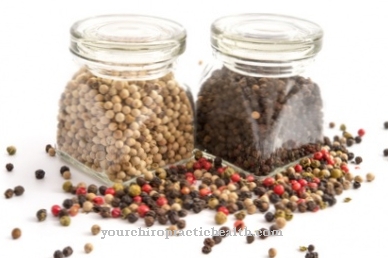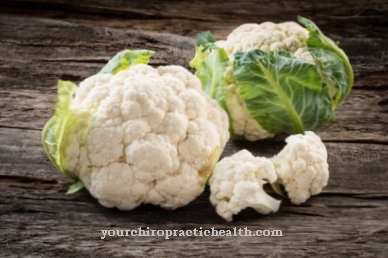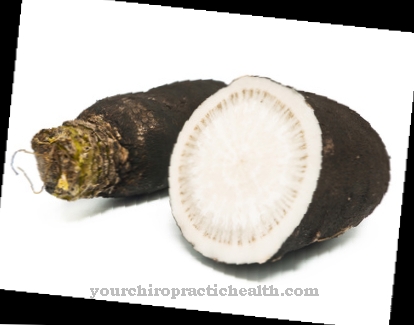The Cantaloupe melon is a popular fruit, especially in summer. It is one of the sugar melons and has a pleasantly sweet flesh with an orange color. One of its greatest advantages is its particularly low calorie content, which makes it a perfect companion in a figure-conscious diet.
What you should know about the cantaloupe melon

The cantaloupe melon (Cucumis melo var. Cantalupensis) is a subspecies of the sugar melon and the sweetest of all melons common in Central Europe. The cantaloupe melon is a particularly noble representative of the melons. It can rather score with inner values, since its skin is not very attractive - the pulp is even more so. She is also called Wart melon known because wart-like bumps can often be found in their shell.
From a botanical point of view, the cantaloupe melon belongs to the cucumber family and is a pumpkin plant. The taste of their pulp is pleasantly sweet and aromatic. The flesh of ripe specimens has a soft consistency and is very juicy. The melon is therefore particularly popular in summer, where it is a refreshing and healthy snack for in between thanks to its high water content.
When cut, it can be recognized by its orange, sometimes slightly pink pulp. When closed, it can be recognized by its light brown shell, which also has a light mesh pattern. The pleasantly sweet scent it exudes is also characteristic of the cantaloupe. The Galia melon, with which it is often confused, has a greenish flesh and is slightly larger overall. The average diameter of a cantaloupe is only between seven and twelve centimeters. It has a weight of 0.5 to 1.5 kilograms. With these dimensions, the cantaloupe melon is one of the smallest types of melon.
The first cantaloupe melons worldwide came from India, Africa and Iran and were already cultivated around 5000 years ago. About 1000 years later, the melon was also widespread in the Mediterranean area. The cantaloupe reached Italy around 1700 and was grown there from Armenian seeds. The local town of Cantalupo in Sabina, which is north of Rome, became its namesake. Almost 40 years later, the cantaloupe melon was also grown for the first time in England.
In addition to Italy, the cantaloupe melon is now mainly grown in Spain and also in France. It is also widely cultivated in the Mediterranean region, particularly in Greece and Egypt. The peak season for the cantaloupe runs from March to September. It is particularly common in the midsummer months.
Importance to health
The cantaloupe has many health benefits. Not only is it one of the particularly low-calorie fruits, it also has a high water content and contains numerous nutrients. Vitamins A, B and C as well as calcium, potassium, manganese, phosphorus and even omega-3 fatty acids are particularly noteworthy in this regard.
Consumption of cantaloupe supports the immune system, keeps eyes, skin and hair healthy and the adenosine it contains even protects against cardiovascular diseases by reducing the chance of blood clots. The high potassium content also helps the body cope with stress. The potassium also regulates blood pressure and supports the supply of oxygen to the brain. In general, the smaller a cantaloupe, the higher its nutritional value.
Ingredients & nutritional values
| Nutritional information | Amount per 100 gram |
| Calories 34 | Fat content 0.2 g |
| cholesterol 0 mg | sodium 16 mg |
| potassium 267 mg | carbohydrates 8 g |
| Fiber 0.9 g | protein 0.8 g |
The pulp of the cantaloupe melon also has a high content of various vitamins and minerals:
- 0.33mg of vitamin A.
- 0.06mg vitamin B1
- 0.02mg vitamin B2
- 0.09mg vitamin B6
- 37mg of vitamin C.
- 0.07mg vitamin E.
- 0.0432g salt
- 9mg calcium
- 0.2mg iron
- 12mg magnesium
Intolerances & allergies
As long as there is no general intolerance to fructose, the cantaloupe melon can usually be eaten without hesitation. However, it does contain salicylic acid, which a few people are sensitive to.
Compared to other melons and other types of fruit, the salicylic acid content of cantaloupe melons is particularly high. In addition, people with a grass pollen allergy can develop a cross allergy with various honeydew melon varieties - including the cantaloupe melon.
Shopping & kitchen tips
The perfect degree of ripeness of a cantaloupe can be recognized by its smell. When the melon is ripe, it gives off a pleasantly sweet scent, which, when overripe, turns into unpleasantly intense to slightly fermented. The peel should be a light yellow or green shade. Unripe fruits, on the other hand, appear greyish-green.
After buying ripe cantaloupe melons, it is best to store them in the refrigerator. Melons that have not yet been cut can be kept there for up to two weeks, but cut cantaloupe melons should be used up after two to three days at the latest. Open interfaces should be covered with transparent film.
Overall, the cantaloupe melon is a rather sensitive fruit. If the temperature is too low, the cantaloupe begins to develop damage caused by the cold: the pulp first becomes glassy and then dark. This is the case at temperatures below three degrees Celsius. Due to its net-like shell, the melon is also a collecting point for bacteria and salmonella and should therefore be processed carefully. The maximum storage time of up to three days after cutting should not be exceeded for this very reason.
A cantaloupe should never be stored near strong-smelling foods such as cheese, as it absorbs external odors quickly.
Preparation tips
The cantaloupe is quick to prepare: First, it is cut in half with a large knife. The seeds inside the cantaloupe can easily be removed with a spoon after cutting in half. Then the halves are cut into segments. The peel can easily be removed with a cut along the pulp. Depending on your needs, the melon can then be cut into bite-sized pieces.
The cantaloupe melon is a refreshing snack on its own. It tastes best straight out of the fridge. However, it also enriches fruit salads and hearty salads and served with good ham it is a real delicacy. The cantaloupe also goes well with spicy cheeses.












.jpg)



.jpg)










.jpg)
